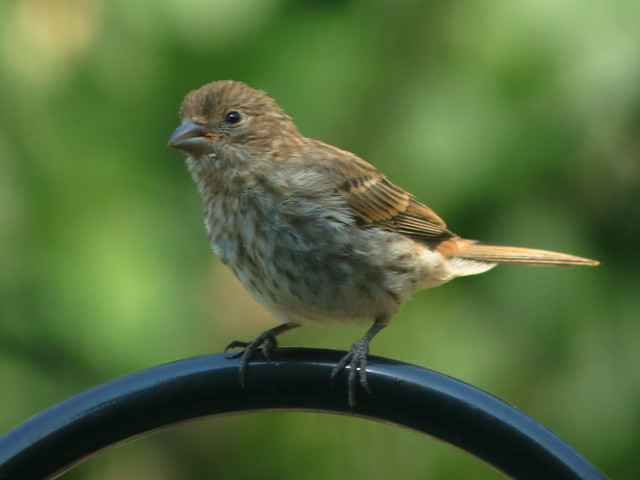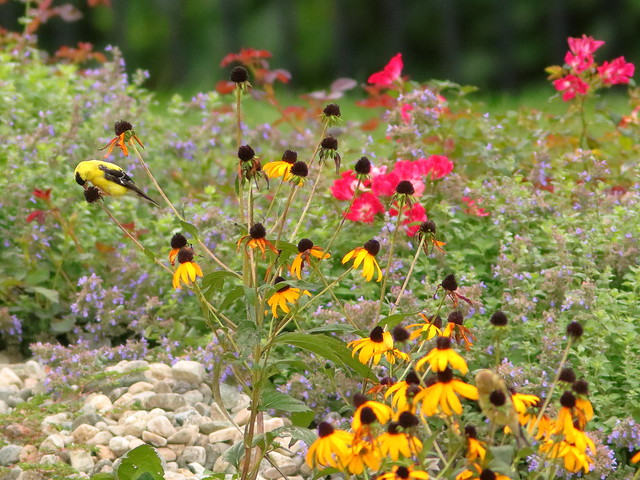For the past eighteen years while we lived in south Florida, we failed to experience the change of seasons as an event. The hot, humid and rainy half of the year melded gently into the dry season with sunny days and cool evenings. The migrating birds were more precise in their scheduled arrivals and departures.
Long-term weather predictions, whether by computer-driven AccuWeather or the competing Old Farmers Almanac, can provide disparate results. Here in New England there is rather precise prediction of the arrival and intensity of colorful fall foliage. Tour companies vie to provide travelers with schedules that exploit the beauty of autumn.
According to the Fall Foliage Prediction Map, central Connecticut can expect the leaves to change to yellow and patchy orange and red around September 26 and reach peak color by mid-October. The intensity and variety of color will depend upon the types of trees and weather patterns which will affect the disappearance of chlorophyll and the emergence of the background pigments such as caretenoids, flavinoids and anthrocyanins.
I am looking forward to my first colorful autumn since moving away from New Jersey and the northern States when I was drafted in 1966. This past week we had an "appetizer" of sorts as an early migrant female Purple Finch was almost invisible in a birch tree which was also getting a head start on the season:
This Purple Finch added to my list of bird species identified (67, of which I have photographed 54 on site) from our back yard since we moved here in early January. She, or another female appeared the next day. Hopefully they will start visiting the seed feeders:
This is a young female House Finch for comparison:
A Black-capped Chickadee peered out from its pine tree perch:
A female Northern (Yellow-shafted) Flicker hunted for ants next to the pool patio. Unlike many other woodpeckers, this species spends much of its time on the ground, probing for adult and larval ants as well as other ground insects:
This male Downy Woodpecker has been sleeping in the vacant bluebird house. This species, as well as several others, often use nest boxes for nighttime shelter against the winter cold. I hope this one does not decide to carve out a back door!
An adult male Eastern Goldfinch extracted seeds from the spent flowers of Black-eyed Susan (Rudbeckia hirta) in the garden:
Immature goldfinches, distinguished from adult females by their darker plumage and tan wing bars, also feasted on the seed heads:
A flock of Wild Turkeys, numbering more than a dozen, foraged in the Sow Thistle (Sonchus arvensis) at the far end of the clear-cut acreage in back of the house. They were barely visible-- these two were the "best" of over 20 photos I took at a distance of 55 meters (~180 feet):
The coats of White-tailed Deer are changing from reddish to dull gray for the winter:
I rescued this terrestrial Wood Frog from the swimming pool. He just hopped away without saying thanks. We are surrounded by consciousness, which I believe to be a fundamental property of matter, usually undetectable, like radiation. It concentrates as the complexity of organisms increases. While the frog may have been incapable of expressing gratitude for its return to freedom, it must have felt relief from the terror of near-drowning:
We encountered this Wooly Bear caterpillar (larva of Isabella tiger moth, Pyrrharctia isabella) on our morning walk along Diamond Lake. Folk wisdom is that if the area of its rust-colored band is less than half that of the black, the winter will be more severe. The caterpillar has 13 segments (said to represent the 13 weeks of winter) and in this specimen, the area appears to involve four segments. Actually, the colored area and the relative size of segments in the middle of its body increase as the caterpillar ages, so this may simply be a young one:
The smooth surface of the lake reflected the greenery:
Sunsets are so varied and spectacular. This view from the upper patio was just after the sun disappeared and the city lights of Hartford were twinkling:
= = = = = = = = = = = = = = =
My Corner of the World
________________________________________________
Please visit the links to all these posts to see some excellent photos on display
________________________________________________



















Lovely autumn views and creatures!
ReplyDeleteGreat sky.
ReplyDeleteAlthough it seems too soon, I love see those autumn colors!
ReplyDeleteI love how in tune with the surroundings you are. That flock of wild turkeys is a treasure.
ReplyDeleteThat's a handy dandy map!
ReplyDeleteI cannot wait for autumn too.
ReplyDeleteWorth a Thousand Words
Hartford seems so wonderful! My mind immediately went to Gilmore girls x)
ReplyDeleteThe view of Hartford is beyond spectacular. Bird photographs are so crisp and clear and like the identifying words you include.
ReplyDeleteThanks for posting all the wonderful birds, as well as other critters in your area! Love the lake and Hartford skyline...wondering on which mountain you live to have that view!
ReplyDeleteThe definition of "mountain" can be vague. I would say we live at 800 feet on a granite mound on the ridge which runs north and south along the east side of the Connecticut River Valley. The northwestern corner of Connecticut has real mountains. Hartford is at about 40-50 ft elevation and the river is at about 13 ft elevation. We have an unobstructed view of downtown Hartford and the waterfront, about 11 m distant.
DeleteWhile we are about to enjoy Florida's transition from green season to brown season, I look forward to vicariously experiencing your New England autumn! Of course, I'll have to crank down the thermostat to pretend it's a crisp fall day.
ReplyDeleteSend those beautiful birds south! We're seeing a few redstarts and warblers as the early fall birds look for worms, and anything else that moves on a twig or leaf.
Ken, sorry you had trouble connecting with the blog. Have made some changes which should fix the issue. Fingers crossed.
Hello. :=)
ReplyDeleteA lovely post with a variety of beautiful birds and other creatures, also stunning sky scene. Thank you for sharing such delightful images.
I very much enjoyed seeing your bird photography. They are such great creatures and so varied in color and activity. Also you have a fine reflection in the water.
ReplyDeleteVery pretty scenic shots. You get such a variety of birds. Enjoy the seasonal change #Allseasons
ReplyDeleteGreat shots! Your fall color comes earlier than ours.
ReplyDeleteI do love birds so much and try to make pictures of them too. Yours are soooo good! I especially like the ones of the in my language 'specht'.
ReplyDeleteWe always heard that the bands on the wooly bear predicted the weather. A wide band of color....hard winter to come! Or is it the other way around? heehee! Love the Goldfinches. Can't wait to see some here. Enjoy your weekend!
ReplyDeleteHello, Ken
ReplyDeleteI am sure the New England states will be filled with Leaf Peepers. The Fall colors sound lovely. Beautiful captures of the birds, I loved all the birds, the Goldfinches on the flowers are favorite this post. The sky shot is beautiful. Thank you for linking up and sharing your post. Take care, have a happy weekend. PS, thank you for leaving me a comment.
This post about the transition to autumn is perfect. I know all those species for once. And this did not make me sad about losing summer!
ReplyDeleteI appreciate you taking time to link up at I'd Rather B Birdin' this week.
ReplyDeleteI envy your location called home with such a beautiful variety of birds
EBird rare birds has it listed as an elegant tern also.
Wow ! The lake scene is stunning. I have never heard of wooly bear caterpillar, that looks creepy but beautiful. I adore your sense of capturing birds. Thanks for sharing with Garden Affair . I always look forward for your post .
ReplyDeleteSuch gorgeous images! Thank you so much for sharing at https://image-in-ing.blogspot.com/2022/09/a-glimpse-of-city-of-brotherly-love.html
ReplyDeleteHello Kenneth! It's been a long time since I visited your blog, been so absent to the blog world for quite some time and I am so happy to be back here on your space, feels like home! Before it was changed to the Philippine Eagle, when i was younger, the Philippine national bird was the 'Maya'. Maya is not a specific bird breed but it's any small bird like sparrows or just like what you shared above, finch. they changed it because the 'maya' seems weak compared to the Philippine Eagle but I think finches and sparrows are not a symbol of weakness but of resilience and joyful and celebratory which I think are traits of my people :)
ReplyDeleteHi, Stevenson--
DeleteSo good to hear from you after so long an absence. I hope all is well.
I tried twice today. First attempt blocked me because my (vacant) message box had been posted.
ReplyDeleteBeautiful post ! Thanks for sharing with Garden Affair.
ReplyDelete